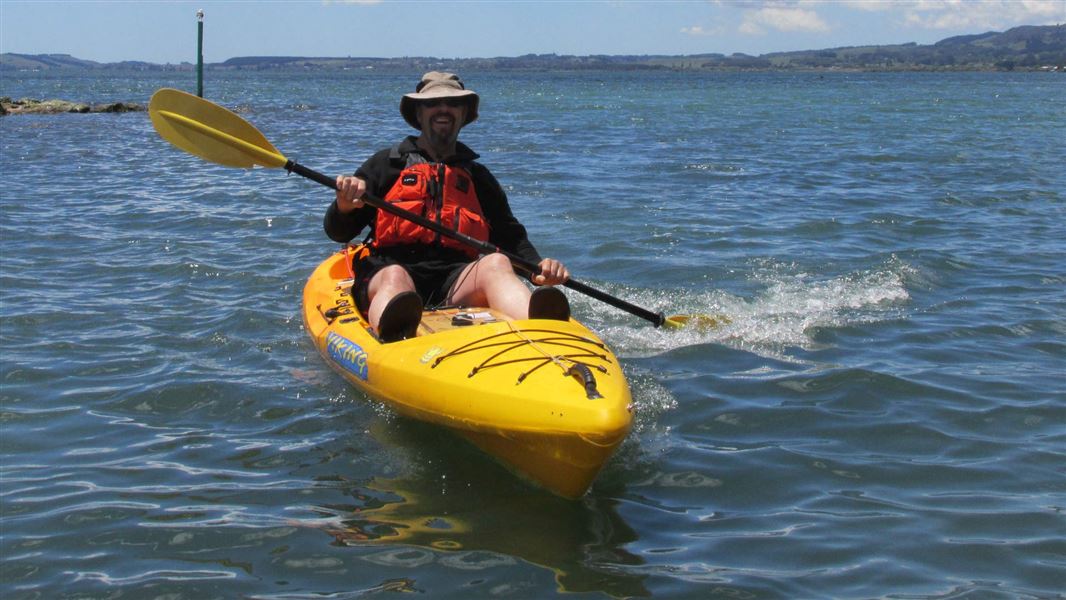
Located in the Bay of Plenty region
Introduction
Discover threatened bird populations living in a harsh geothermal landscape.The south-eastern corner of Lake Rotorua is known as Sulphur Bay and is made up of a Wildlife Refuge and a Wildlife Sanctuary.
The bay stretches from Motutara Point arross to Ngapuna. The Purenga stream flows into the Bay which has plenty of geothermal features including boiling mudpools, naturally hot water and steam.
Sulphur Bay is accessible from the Rotorua CBD. Free parking is available in Rotorua’s Government Gardens or at the Lakefront. From the Lakefront, follow the road past the waka on display.
Although a boat ramp is present at Mototara Point, mechanically powered boats are not permitted in the Wildlife Refuge at any time. Restrict the use of mechanically powered boats to the other parts of Lake Rotorua.
Stick to the speed limit at all times. Dabchick nests are easily swamped by boat wash.
Don’t disturb wildlife. Threatened bird populations live and breed around Sulphur Bay and are sensitive to boat wash and foot traffic.
In the Rotorua District, dogs are not permitted in reserves unless designated a dog exercise area.
Check, clean, dry between waterways. Report pesh fish sightings to your local DOC office or 0800 DOC HOT.
The Sulphur Bay Wildlife Refuge occupies a 145 ha portion of the bay and is home to an array of bird species including the nationally threatened New Zealand dabchick, banded dotterel and black-billed gull.
The water in the bay appears murky due to sulphur suspensions in the water. The water is low in oxygen and quite acidic (pH 3.5). Birds are often seen with the webs of their feet eaten away by the acidic waters.
Birdlife
Few birds feed in the bay as few insects and larvae can tolerate the acidic conditions. Warmth, refuge and close proximity to food in other parts of the lake are likely reasons for birds to be present in large numbers. Birds have fast metabolic rates and need much energy to fuel flight – geothermal warmth would help conserve energy usually used to keep bodies warm.
The gulls of Sulphur Bay are quite unique in that they are not usually found in geothermal environments. These species are typically found along braided rivers and principally in the South Island. Just 5% of the total black-billed gull population is found in the North Island of New Zealand.
Black-billed gull (tarāpuka) and red-billed gull (tarāpunga) populations have nose dived in recent years.
The black-billed gull has the undesirable status of being the most threatened gull species in the world. Weed encroachment has removed suitable habitat or ground nesting and predation by cats, rats and stoats has also affected the population.
They are only found in New Zealand and currently classified as being Nationally Critical. Population decrease is largely due to water quality decrease and predation by rats, mustalids and feral cats. The black-billed gulls don’t scavenge to the extent that the other gull species do, but they can be seen feeding on insects and worms on agricultural land in the catchment.
The red-billed gull is the most common gull on the New Zealand coast. Except for the unique colony around Sulphur Bay, it is rarely found inland. In parts of New Zealand red-billed gull populations have declined by as much as 51% resulting in the species currently being classified as Nationally Vulnerable.
Plantlife
Sulphur Bay is a harsh environment for plants. Geothermal soils are infertile with unusually high levels of sulphur and iron. Not only do plants have to tolerate poor soil but they’re also exposed to steam and toxic gases.
Despite these harsh conditions specialised geothermal vegetation with needle – like leaves, slow growth rates and irregular flowering habits are reasonally abundant. Turutu ( blueberry) grows along the edges of the paths in clumps and raupo (bulrush) can be seen growing in the water at the lakes edge in some places.
There has have been some notable battles between Maori tribes that occurred in this area. Utu was once a way of life and on one particular occasion in the early 1600’s, a Tuwharetoa war party from Taupo was causing trouble in the area.
As they journeyed back to Taupo, a small Ngati Whakaue war party from Mokoia pursued them. The Tuwharetoa turned back, bringing re-enforcements with them. Te Roro-o-te-rangi, chief of the Ngati Whakaue stood his ground and roused his warriers to join him against the Tuwharetoa.
In the battle that followed Te Roro-o-te-rangi’s brother was killed. His other brother Tunohopu fought strongly against Kaipahu the chief of Tuwharetoa. Because Tonohopu was an equal match for Kaipahu, he was spared and left guardian of the lake.
Te Roro-o-te-Rangi was captured and taken to Taupo to be paraded as a trophy until he was finally put to his death. Many Ngati Whakaue lost their lives in this battle.
Check, Clean, Dry
Clean all gear when moving between waterways to prevent the spread of didymo and other freshwater pests.